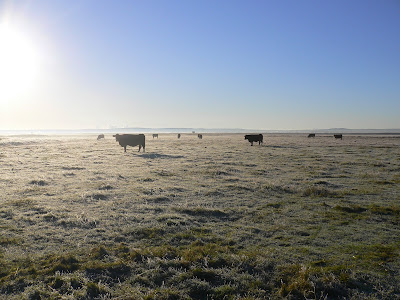
I have mentioned the Minster beach area on Sheppey in a previous blog but not with photos. It is on Sheppey's northern coast and faces the Thames Estuary and the Essex shore.
The "Shingle Bank" shown above is only a short stretch of artificialy created bank that borders the road between Minster and Sheerness and is the first line of flood protection. Prior to 1960 the short stretch of road that you can see was not there, it was basically an unmade, pot-holed track, subject to flooding by the sea and unsuitable for ordinary traffic. The main seawall was the one to the left of the picture (double click to enlarge the photo) and old photos show the area between it and the beach as primarily just something similar to salt marsh. Behind the older seawall was a large stretch of marshland, which is still there, which was used as a military firing range. Huge targets were in place a short way behind the seawall and when firing torwards them was taking place, military guards at each end of the seawall would direct the walking public through a long "covered way" that was between the seawall and the targets.
The current "Shingle Bank" is used most days throughout the year by windsurfers, kite-boarders, fishermen, but occasionally throws up some interesting bird life and has an impressive list of wild flowers. In hard weather Snow Buntings can be found there and I actually saw my very first Snow Bunting there when the bank was first being created in around 1959/60. Despite the constant daily disturbance, a few years ago a pair of Little Terns somehow managed to rear a brood of chicks there, regularly shepherding their chicks further along the beach away from large groups of picknicking and windsurfing families. At high tide in the winter months there are also good-sized roosts of mixed waders there along the water's edge, birds such as Sanderling, Ringed Plovers and Turnstones, sometimes in many hundreds.
Wild flowers along this bank are numerous and feature Lucerne, Yellow-horned Sea Poppy, Sea Kale, Sea Campion and the rarer Dragon's Teeth, as some of the more uncommoner ones.
At the far end of the "Shingle Bank" and the road, is the entrance to what used to be the old firing range and which has now been landscaped into a country park, known as Bartons Point Country Park. This park is seperated from Sheerness by an old canal of several miles, that was created in Napoleonic times to enable Sheerness and its military garrisons to be defended from all sides. Unfortunately the section of the canal adjacent to the park has its water levels maintained by regular topping up with seawater through a sluice at its seaward end and this has created a stretch of water that is pretty much useless to most forms of fresh-water loving wildlife. The flipside being that it does now have an active population of both jellyfish and cockles that have entered with the sea water and bred successfully.
When the park was created a large lake, unfortunately fed by seawater from the canal, was also created.

During most winter months both the adjacent canal and the lake, are home to a large number of Little Grebes, often totalling 60+ birds, although apart from a few dozen Wigeon and Oystercatcher and the odd Bar-tailed Godwits and Curlews, that is it. Why it is so attractive to the Little Grebes is hard to know, presumably the sluice allows in large numbers of small fish, or they have created a breeding colony in there.

If you were to turn round in the "Shingle Bank" photo above you would be facing Minster Leas, a stretch of expensively landscaped crumbling cliffs and pedestrian promenade that after a mile or so revert to high, dangerous and ever-eroding cliffs that continue all the way round to Warden Point.
The landscaped stretch of the Leas is very popular with the public for much of the year and despite its slopes tending to be rough and overgrown with various grasses and lucerne and ever increasing shrubs and brambles, it still offers little in the way of wildlife. Apart from a few pairs of Whitethroats in the summer and regular Med. Gulls, birdlife is very limited although there have been two exceptions, a couple of years ago a Dartford Warbler appeared and many years ago, a Blue Rock Thrush!
The only other point of interest along this stretch is the beach below the crumbling cliffs that you can see in the distance, at low tide it has always been a magnet for fossil hunters, with shark's teeth of all sizes being the more commoner finds.






























